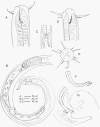|

Tripylina bravoae A-C: Female. D-G: Male. A: Anterior
region. B: Posterior region. C: Cardia. D: Anterior end. E: Face view. F:
Spicules and gubernaculum. G: Posterior region lateral showing spicules,
gubernaculum and supplements, and spermatozoa.
from Cid del Prado et al., 2012
|
General Characteristics:
Body long and slender, spiraling ventrally in the
posterior region after fixation.
Cuticle 1-2 μm thick with very fine
transverse striation, indiscernible under LM but visible under SEM; with
sparse somatic setae.
Lip region asymmetric, 20-26 μm wide, separated
from the body contour by a slight constriction.
Stoma with three
triangular lips.
Inner labial papillae small, conical, 2 μm long, two at
the base of each lip; six outer labial setae strongly developed, 13-20
μm long; four cephalic setae 5-8 μm long, in a single whorl with the outer
labial setae.
Amphid apertures oval, at 19-27 μm from the anterior end.
Stoma opening shifted dorsally, with its wall thickened dorsally.
Strong dorsal tooth directed posteriad, 2 μm long, located 18-35 μm from the
anterior end and posterior to the two minute subventral teeth.
Pharynx
heavily muscular in the posterior part, separated from the intestine by a
large cardia with two pericardiac cells.
No excretory pore.
Two
ventromedian setae in the cervical region in males but absent in females.
Rectum 0.8-1.3
times as long as anal body width.
Tail curved in a
ventral spiral, the first third wide but then tapering to a slender
cylindrical shape.
Caudal glands occupying almost the full width of the
tail.
Tail terminating in a small spinneret.
Female:
Cardia 11-19 μm long and 17-25
μm wide.
Distance from posterior end of pharynx to vulva 763-1244 μm and
from pharynx base to anus 1133-1398 μm.
Reproductive system
monodelphic-prodelphic: ovary short and reflexed; uterus 80-109 μm long;
vagina short, with two oval sclerotized pieces; vulval lips slightly
protruding; post-uterine sac 130-175 μm
long..
One pair of small
latero-dorsal setae.behind the anus.
Male:
Slightly larger than female. Cardia
12-17
μm long and 23-25 μm wide.
Distance from posterior end of
pharynx to cloaca 1513-1724 μm.
Genital system monorchic, with
74.5-105.7 μm long testis.
Sperm cells oval, 8-12 μm long and 6-8 μm
wide.
Five pre-cloacal supplements.
Spicules sickle-shaped with bifid
terminus and completely surrounded by a muscular sheath.
Gubernaculum
U-shaped.
One pair of small, latero-dorsal setae behind the cloacal
aperture.
|